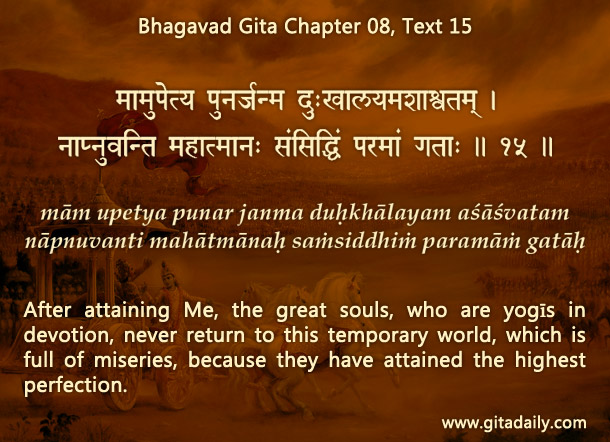Some people ask, “Devotees and non-devotees both have to die – so what’s the use of practicing spirituality with all its restrictions?”
That’s like asking: in a hospital, those who cooperate with the treatment and those who don’t both have to go out of the hospital – so what’s the point of taking treatment?
The point is that the two will go to different destinations: those who take treatment will return to normal healthy life, whereas those who don’t will go to the graveyard.
The world we live in is like a hospital. The disease we all suffer from is misdirection of our desires – though we are eternal spiritual beings, we are trying to enjoy temporary material things, getting in the process little pleasure and much suffering. Bhakti-yoga is the therapeutic process that cures our desires, redirecting them from matter to Krishna, who is the supreme eternal reality, the source of all happiness.
For those who reject the bhakti treatment, death is not mere destruction; it is actually something scarier: total deprivation. Destruction would mean the end of existence and with it the end of suffering. But non-devotees, like everyone else, are eternal souls. So at death they get separated from everything they have held dear. And unfortunately their misery doesn’t end with the deprivation – it extends to a post-mortem reaping of karmic consequences because in this life they usually seek pleasure through actions that comprise bad karma. Or in terms of our analogy they unwittingly complicate their disease and have to endure further suffering in their future bodies – till they finally take the bhakti treatment.
Devotees, on the other hand, get cured and attain the spiritually healthy state of eternal life with Krishna, as the Bhagavad-gita (08.15) indicates. Thus death for the devotees is not a scary destruction, but a happy discharge.

Explanation of article:
Podcast

Wonderfully explained with example of life as hospital. Hari bol !! Sril Prabhupad used another very nice analogy. I would like to mention it here. Death for devotees is like cat holding her child in her mouth but for non-devotee it is like cat holding a rat in her mouth.
Wonderful explanation. Your snippets of wisdom makes my day and propels me to move ahead inch by inch in Krsna Consciousness. Thanks a ton
Let us continue to get recharged by wonderful explanation of
Bhakti-yog and get cured or/and discharged happily.
Thanks. Also my heartfelt thanks for starting Bhagavatam Daily.
Hari Hari bol